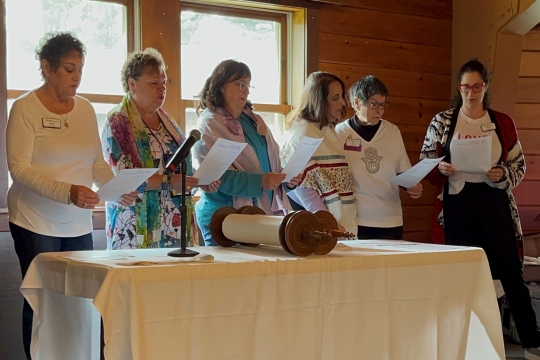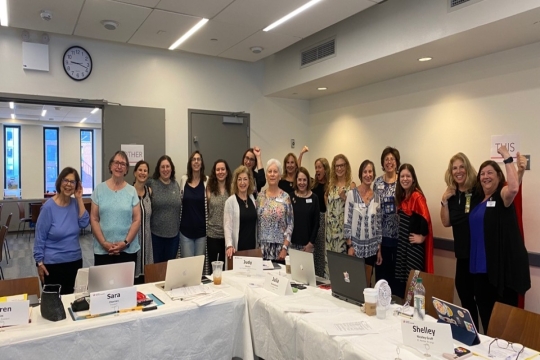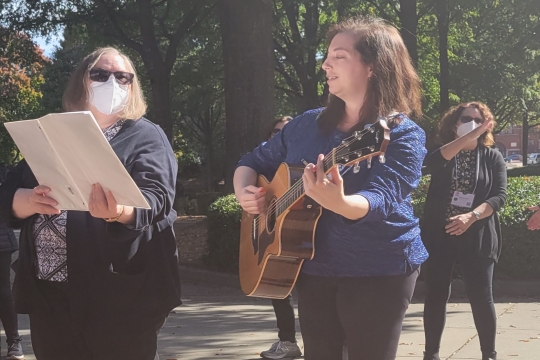by Judith Shor Ning
This portion relates the covenant that God offered the people of Israel, Moses’ demands to Pharoah, and the first of the plagues. In spite of the participation of the “People Of Israel” in this process, women are not really mentioned (although lines of descent do name four women in 6:14-24). We know our foremothers were there, and included in that covenant—“I will take you to be My people, and I will be your God”—and we certainly know how central they have always been in maintaining our relationship with Adonai, but they remain unacknowledged.
Lately I have been mulling and kvelling over WRJ’s support of NFTY’s 75th birthday. In our own “covenant” with them, and like the unnamed women, we birthed a “people” (NFTY itself) and have supported this part of our family through its life.
NFTY has long been a part of my own family. My mother was among its first members as a Depression-era 19-year old in New York City. As NFTS (now WRJ) pushed the congregations to form NFTY, so she pushed OUR congregation to affiliate their youth (TASTY) in 1960. (My own daughter later became TASTY’s president.)
With such a pedigree, I served as a member of the NFTY board while celebrating its 25th anniversary. I still have memorabilia: my nametag, the celebratory menu, AND a receipt for the $40 registration fee. We convened at C.W. Post College (now LIU Post) and that year our board accepted the gift of Kutz Camp, establishing The Place for leadership development. We also attended the NY World’s Fair (picture two dozen NFTY board teens singing motzi in an international dining venue).
I attended “boards” as the president of SWFTY (NFTY-SW), and recall being the first girl elected president of my region and the only (I believe) female regional president on the national board. It was a time when even youth group presidents were predominantly boys, although I often noticed a girl would do most of the work.
Similarly, congregation sisterhood women underpinned activity in their temples. They promoted Shabbat, Friday services, and onegs. We hear how often it was the women who pushed for the hiring of clergy. In one congregation, the sisterhood women gave monthly Friday-night sermons for some half a century. Within its first decade, WRJ heralded the experiment of electing women to synagogue boards; called for our members, in the absence of vacationing rabbis, to lead summer services; and proclaimed Sisterhood Sabbath, a day when women could lead the service and preach to the entire congregation.
And today? Now girls figure heavily in NFTY leadership at every level. Women are omnipresent on congregation boards and as clergy and professional staff.
Not all has changed. In Israel the Women of the Wall battle for equality. We are fighting our own national issues of pay equity. These exemplify current plagues, demonstrating that the work of women continues to be under-recognized and undervalued.
To better understand (and likely increase your agitation over) the struggle in Israel, I encourage you to read and discuss: The War on Women in Israel: A Story of Religious Radicalism and the Women Fighting for Freedom by Elana Maryles Sztokman.
Ongoing WRJ advocacy programs help us to confront our national and local challenges. I see us in covenant, partnering with God to free ourselves from modern kinds of bondage, and to repair our world. As always, we are “stronger together.”
Judith Shor Ning is a WRJ Board member and past president of Congregation Albert Sisterhood in Albuquerque, NM. As WRJ Pacific District First Vice President, she finally gets to actually see Camp Kutz (50 years after her vote to birth it).
Related Posts
Image

Parashat Yom Rishon shel Rosh HaShanah
September 14, 2023
During the High Holidays, my thoughts turn to the special blessings, prayers, and melodies that shape our journey from Selichot to Rosh HaShanah to the final shofar blast on Yom Kippur. Many of our prayers in the High Holiday liturgy are written in the plural.
Image

Cultivating a Culture of Accountability and Belonging
September 8, 2023
And, we’re off! Many of us have worked over the summer with friends and colleagues to set the calendar for the year ahead, including meetings, events, and other opportunities for gathering.
Image

My Journey from Altar-Girl to Cantorial Soloist
August 11, 2023
I was born a Goldman, and always knew I was Jewish on my dad’s side. Although my whole family was spiritual in their own way, the Jewish side of my family didn’t have warm feelings towards religion, and the only thing passed down to me was the Jewish humor I grew up in New Jersey and had an open...
